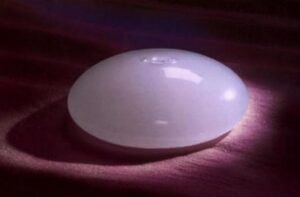Dr. John Q. Cook, founder of the Whole Beauty® Institute in Chicago and Winnetka, is well-known for his emphasis on a natural approach to breast augmentation. Our entire team is committed to providing you with an excellent experience, before, during, and after surgery.
As part of this approach, we make sure that you have no unanswered questions prior to your surgery. That way you will approach the day of surgery with confidence and peace of mind.
We have developed on the website a page that provides a potential patient with 10 questions to ask a surgeon during a breast implant consultation. We recently created a blog that provides 10 important things to know for anyone considering breast augmentation surgery.
Here are 10 questions that we frequently hear from patients who are considering breast augmentation surgery. Dr. Cook’s answers will help you understand the nature of the operation, the pros and cons of different techniques, and what to expect during your recovery.
1. What does the number of cc’s in a breast implant mean?
The term “cc” is short for cubic centimeters, and it is a measure of the volume of a breast implant — that is, the amount of saline solution or silicone gel that the implant holds. The higher the cc number, the larger the implant. It is a common misconception that a certain amount of cc’s corresponds to a particular bra or cup size; in fact, the same size implant can have very different results for different clients. This is because even if two patients have roughly the same breast size, their breast structure may be very different. A woman who has had 3 children will have a much softer breast structure than a younger woman who has not been pregnant.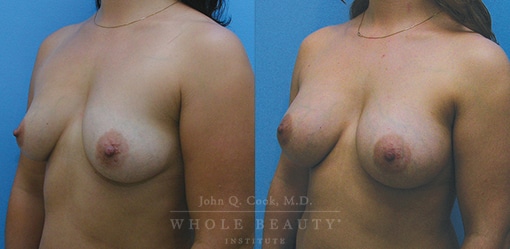
2. What is capsular contracture and how do I recognize it?
Capsular contracture is a relatively uncommon complication of breast augmentations that occurs when the protective capsule of scar tissue around your implant becomes overly hardened. Only about five percent of breast augmentation patients will develop severe capsular contracture. Capsular contracture may occur in one or both implants.. The cause of capsular contracture is not fully understood, which makes it very difficult to predict. However, some conditions often precede capsular contracture, including subclinical infection, bleeding, silicone leakage, excess activity after surgery, and radiation therapy. The main sign of capsular contracture is a breast that feels hard or tight, sits higher on the chest or appears misshapen. It typically occurs within the first two years after your augmentation surgery, but it can occur later with both saline and silicone gel implants.3. Will I lose sensation in one or both of my nipples?
Almost all breast augmentation patients will experience some loss or change in sensation immediately following their surgery. While this typically resolves itself over the course of your recovery, a small amount of nipple sensation loss — between 5 and 10 percent — is considered normal following a breast augmentation surgery, depending on your procedure technique. It is not always identical or even on both breasts. We usually tell our patients to allow six months of healing before assuming that their nipple sensation has reached its new “normal.” Nipple sensory loss is much more common in patients with oversize implants because the base of the implant is so large that it requires the surgeon to undermine in the area where the sensory nerves enter the breast structure.4. How can you ensure that the implant will look natural beneath my breast?
Breast implant “rippling” occurs when the implant is placed incorrectly, so that the contours of the implant are visible. This can happen when an inexperienced surgeon uses an implant that is not adequately covered by natural breast and skin tissues, particularly when the implant is placed with a subglandular (below the mammary gland) approach rather than a subpectoral (below the pectoralis muscle) approach. It can also be caused by an incorrectly filled implant — an underfilled or overfilled implant is more likely to develop abnormal bumps or ridges that may be visible on the surface of the breast. Rippling can be avoided by using an appropriately sized implant and an appropriate placement technique based on the patient’s natural breast tissues and body type. Dr. Cook and his experienced surgical team will be able to help you make these decisions after an in-person evaluation at your consultation.5. What are the reasons for placing breast implants above or below the muscle?
In the United States, the subpectoral approach has become the typical technique for breast implants. This approach has a few advantages, including a more natural slope of the upper portion of the breast as well as a larger amount of natural tissues between your implant and your skin to hide imperfections in the shape of the implant. Some research also suggests that subpectoral implants have a lower chance of capsular contracture, and that implants placed above the pectoral muscle can interfere with mammogram results.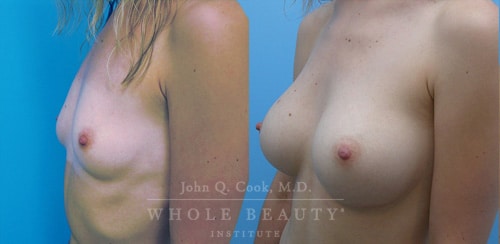
6. Can I use breast implants to correct sagging instead of a breast lift?
Some breast implants — known as high-profile implants — are designed to give the breast more lift and projection. However, with plastic surgery, it is always best to choose the procedure that will most directly address your concerns. If you have breast sagging (breast ptosis), a breast lift is simply the right surgery for you. Using implants to try and correct this is likely to leave you disappointed with your results, and can even make sagging worse over time by adding weight to your breasts without correcting the underlying problem.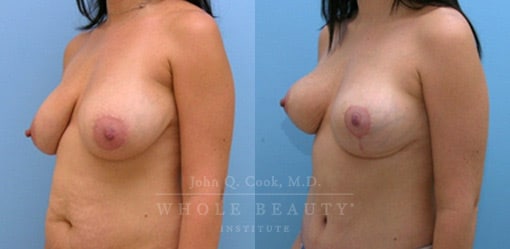
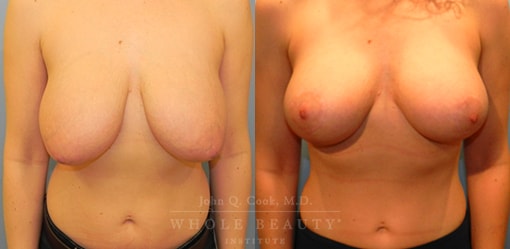
7. Can my breast implants give me cleavage?
The amount of cleavage that you have following a breast augmentation depends more on the natural placement of your breasts and the width of your rib cage than it does on the size and type of your implants. Breast augmentation surgery increases the volume of your breasts, but it does not reposition them relative to your chest wall. If your breasts are wide-set before your surgery, your augmentation is unlikely to give you more cleavage au naturel. However, increasing the size of your breasts typically makes it easier to create cleavage with the right undergarments.8. Do I need to fully fill my saline implants?
Improperly filled saline implants are one of the biggest mistakes that an inexperienced plastic surgeon can make. Unlike silicone implants, saline implants are manufactured empty and filled after they are inserted. Your saline implants come with a minimum and maximum volume so that your surgeon can achieve the ideal breast size while filling your implants. However, missing the mark on the minimum-maximum fill range can easily lead to complications from or dissatisfaction with a breast augmentation. Underfilled saline implants can increase your chances of deflation, rippling or an unnatural breast shape, while overfilled implants have been linked to capsular contracture and a higher chance of rupture. Overfilled saline implants also tend to create an unnatural ball-like appearance to the breast. A saline implant should be carefully filled to its exact specifications to ensure proper breast size and texture as well as the safety of the patient.